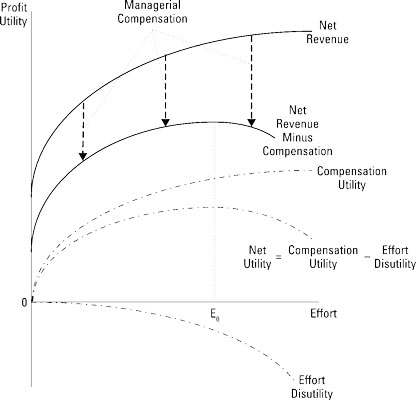Managers increase effort if they have an incentive to do so. One method absentee owners use to increase effort is profit sharing. Profit sharing indicates that managers receive some share or percent of profit. Thus, as profit increases due to increases in managerial efforts, managerial compensation increases.
The illustration shows the impact of a profit-sharing arrangement for both the firm — solid lines — and manager — dash-dot lines. The firm’s net revenue again increases at a decreasing rate. However, net revenue minus managerial compensation now changes.
Initially, net revenue minus compensation increases at a decreasing rate; however, it now reaches a maximum and then begins to decrease. This decrease is the result of the continued increase in managerial compensation. The vertical difference between the net revenue curve and the net revenue minus managerial compensation curve gets larger as the manager receives more compensation for greater effort.
For the manager, compensation increases as effort increases. However, the utility the manager receives from that additional compensation increases at a decreasing rate due to the law of diminishing marginal utility. At the same time, greater effort continues to generate disutility.
As a result, the manager’s net utility — the utility from compensation minus the disutility of effort — initially increases, eventually reaches a maximum, and then begins to decrease. The manager’s situation is represented by the dash-dot lines in the illustration.
The manager chooses the level of effort that maximizes net utility. In the illustration, this corresponds to the effort level E0. Note how this is different from the flat salary. With the flat salary, the manager wants to expend as little effort as possible. With compensation tied to effort, the manager now works harder in order to get more utility or satisfaction.

The owner needs to develop a profit-sharing plan that results in managers maximizing their net utility at the same level of effort that maximizes net revenue minus the manager’s salary — the owner’s profit. Determining this balance point is a critical task for the owner.






